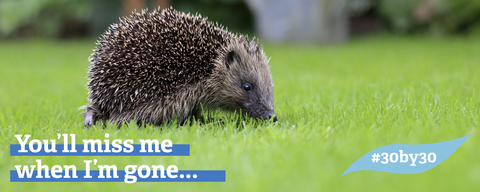
Our natural world is in trouble
This is no secret. Wildlife is disappearing at an alarming rate - some are calling it the next mass extinction - and the threat of climate catastrophe is a constant worry. We live in a time of emergency.
There is still hope - we can tackle both of these critical issues - but we have to act now. Time is running out.
What needs to happen?
The Wildlife Trusts are calling for at least 30% of our land and sea to be connected and protected for nature’s recovery by 2030. Making more space for nature to become abundant once again will give our struggling wildlife the chance to recover and also restore beautiful wild places - places that store carbon and help to tackle the climate crisis.
In Cumbria only 15% of land is currently protected for wildlife and only one fifth of this protected land is in a good condition for wildlife.
In the North West of England, 41% of the Irish Sea is ‘protected’ but only 5% has any sort of protection measures, and 0% is fully protected.
30% is the bare minimum that nature needs to start recovering but we are far short of this and need your help to turn things around...
The Wildlife Trusts are calling for at least 30% of our land and sea to be connected and protected for nature’s recovery by 2030. Making more space for nature to become abundant once again will give our struggling wildlife the chance to recover and also restore beautiful wild places - places that store carbon and help to tackle the climate crisis.
30% is the bare minimum that nature needs to start recovering but we are far short of this and need your help to turn things around...Chief Executive, The Wildlife Trusts
We can do this together
By joining our mission for nature's recovery, you will make a real difference to wildlife and our natural world. Every pound donated will help us achieve our vision for a wilder future. Together we can restore huge peatlands, which store carbon and become a home for threatened birds like curlews and golden plovers. We will create new wetlands, which reduce the risk of towns and villages flooding and are also great for dragonflies and water voles. We will plant new underwater seagrass meadows to soak up carbon and shelter sea horses and other sea life.
Nature has given us so much, it's now our turn to give back.
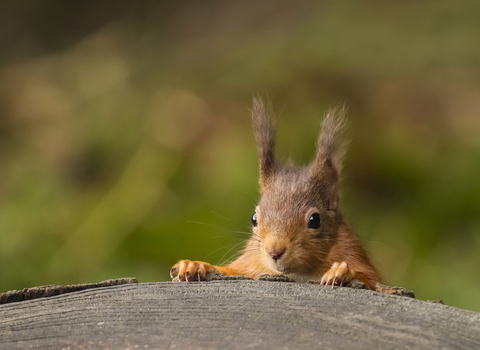
Red squirrel © Andy Nayler
Bringing nature to more people
Stunning scenery provides a backdrop to Smardale Nature Reserve. This wonderfully varied site stretches from Newbiggin-on-Lune almost as far as Kirkby Stephen.
The steep, wooded slopes at Smardale Nature Reserve are home to an important population of rare red squirrels. The nature reserve has recently been extended and we have installed a new and specialist feeding station to give visitors better views of these iconic animals.
For those who can’t visit the nature reserve, we want to put up a new webcam, so people can enjoy watching red squirrels online and at home. We also want to create family trails, offering a chance for younger visitors to develop a passion for nature, with ‘wild’ backpacks to borrow, packed for a day’s wildlife adventure.
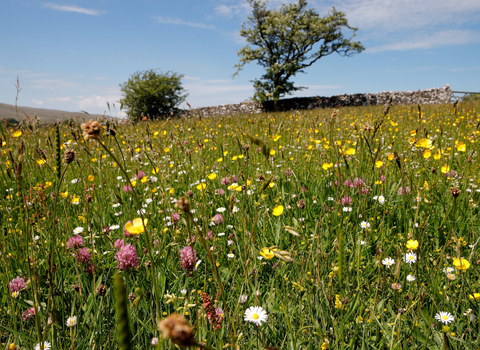
Bowber Head Farm © Cumbria Wildlife Trust
Restoring wildflower meadows
We're improving 12 hectares of historic northern hay meadows for wildflowers at Bowber Head Farm near Ravenstonedale. With their colourful flowers and herbs, the fields at Bowber Head Farm are very special. With only 9km2 of northern hay meadows left in existence, these are the most threatened and vulnerable wildlife habitats in Cumbria.
We're plug planting and using ‘green hay’ to redistribute seeds around these precious 12 hectares to restore them to top condition following a decline in the quality of the grasslands over the last 20 years.
From 2021 we’re also leading work in Cumbria to restore 50 hectares of meadows at locations across the county. We’re working with farmers, small holders, conservation workers and local communities, and running a trainee support programme. We’ll also help people reconnect with nature, by running public events to raise awareness of meadows and species-rich grasslands.
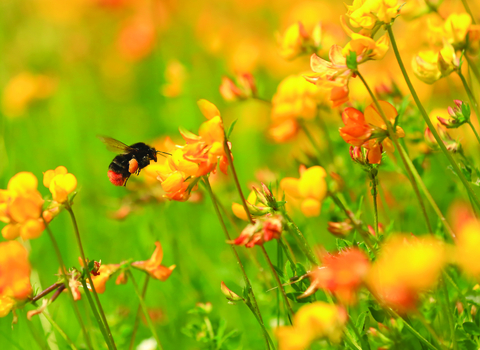
Red-tailed bumblebee © Jon Hawkins/Surrey Hills Photography
Protecting our pollinators
Pollinators depend on flower-rich habitat to survive and over the last 75 years across England we’ve lost 97% of our flower rich meadows, 50% of our hedgerows, and 60% of flowering plants are in decline.
To combat this loss, we’re working closely with partners and local communities in north west Cumbria, to create over 115 hectares of wildflower rich habitat for pollinators, at over 62 sites. Creating these stepping stones of habitat will help link natural environments and green spaces, enabling our pollinators to travel more freely across the landscape.
From 2021 we’re expanding this work further across the north of Cumbria by creating and improving another 158 hectares – that’s around the size of 94 football pitches - of pollinator-friendly habitat. We'll work with the county council, local communities, landowners and organisations, to create pathways for pollinators through our towns and countryside. We’ll provide opportunities for volunteering and employment for young people who want to start a career in practical conservation.

Temperate rainforests, with their ancient trees, are cool, damp places with huge biodiversity - Staveley Woodlands Nature Reserve © Danni Chalmers
Looking after ancient woodland
Staveley Woodlands is a wonderful ancient woodland, including Craggy Wood and Dorothy Farrer's Spring Wood. The beautiful woodlands at Craggy Wood will be protected for many years to come, thanks to our wonderful supporters who donated to the Save Craggy Wood Appeal.
In 2018, Craggy Wood was purchased from The Lake District National Park and its future is safe.
Working with volunteers, we're connecting Craggy Wood with rest of the Staveley Woodlands, creating a fantastic wildlife corridor. We've a dedicated Staveley Woodlands Officer who works with the local community to ensure this precious woodland is an even better place for wildlife and a great place for people to visit.
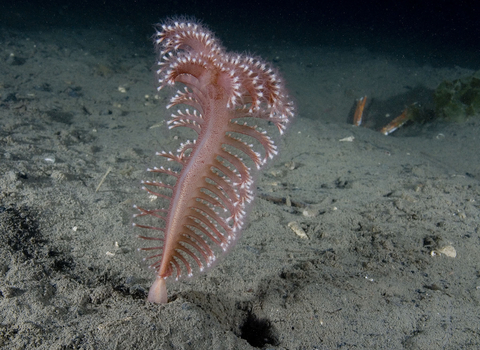
Phosphorescent sea pen and Dublin bay prawn © Paul Naylor
Keeping our seas healthy
The sea plays a vital role in regulating the health of our planet. Seas absorb 20-35% of human-made CO2 emissions every year so are great carbon stores. However they have been damaged by human activity such as trawling and dredging, causing a loss of marine wildlife as well as carbon.
The Irish Sea off Cumbria boasts five Marine Conservation Zones (MCZs), which have been created to help heal our wounded sea life. There’s still a long way to go though, as despite this designation, trawling (and other harmful activities) can continue in these protected sites, further damaging our marine life and destroying carbon stores.
West of Walney MCZ, off the coast of Walney Island, was designated as a Marine Conservation Zone in 2016. It contains sensitive mud habitats and wonderful communities of marine life, damaged after years of destructive fishing activity. We campaigned to help secure a ban on trawling within most of this site, which came into effect in 2019. This will help protect its amazing wildlife, including brittlestars, urchins, Dublin Bay prawn (also known as scampi) and delicate sea pens (left), and reduce the amount of CO2 released back into the atmosphere. We're continuing to campaign for Highly Protected Marine areas in the Irish Sea, to help our seas recover.
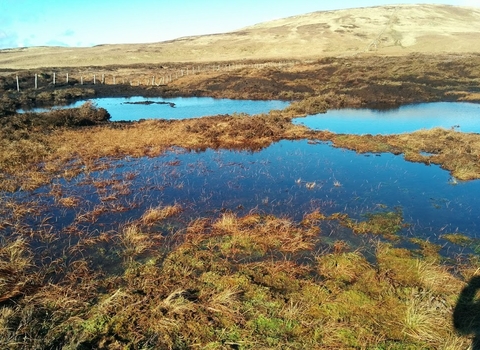
Armboth Fell after peatland restoration © Cumbria Wildlife Trust
Repairing our peatlands
Peatlands are amazing. They cover just 3% of the world's surface, yet store nearly 30% of the world's soil carbon. Healthy peatlands also slow the flow of rainfall, reducing the risk of flooding and provide a home for a wonderful array of wildlife.
However, we need to protect and repair them, as so many of them are damaged, allowing damaging CO2 to leak back into the atmosphere.
We've been restoring upland peatlands since 2001 and in 2022 we worked in partnership with National Trust, United Utilities, Fix the Fells and Natural England to restore 21 hectares of damaged peatlands at Armboth Fell near Keswick. As a result we estimate 23 tonnes of CO2 per year will be saved from entering the atmosphere.
Volunteers helped us plant thousands of plugs of cotton grass and heather by hand across areas of exposed peat. This species is native to peatlands and wetlands and as the plants grow their root systems will help stabilise the restored areas and reduce erosion.

We have a great opportunity to create more space for wildlife at Cold Springs in the future © Cumbria Wildlife Trust
Creating space for wildlife
Cold Springs (left) is 15 hectares of farmland on the outskirts of east Penrith, gifted to Cumbria Wildlife Trust by Brian and Ann Clark. Although this land is not currently home to much in the way of wildlife habitats or species, there’s an opportunity for us to create more space for wildlife here in the future.
Only 15% of Cumbria’s land is protected for wildlife - this isn’t enough. We’re calling for 30% of land to be connected and protected for wildlife by 2030. Cold Springs and other places like it could help us reach this target.
Sir David Attenborough said: “Every space in Britain must be used to help wildlife".
The benefits of making farmland better for wildlife would be wide-reaching for people and for nature. It would improve resilience by enhancing nature’s ability to prevent flooding and improve air quality, boost the recreational and tourism economy, create new environmental jobs, and help tackle the climate emergency by storing carbon.
We took ownership of Cold Springs in 2021 and our plans are still in the very early stages. Keep an eye on our Community Development Team page to find out how these plans take shape.
